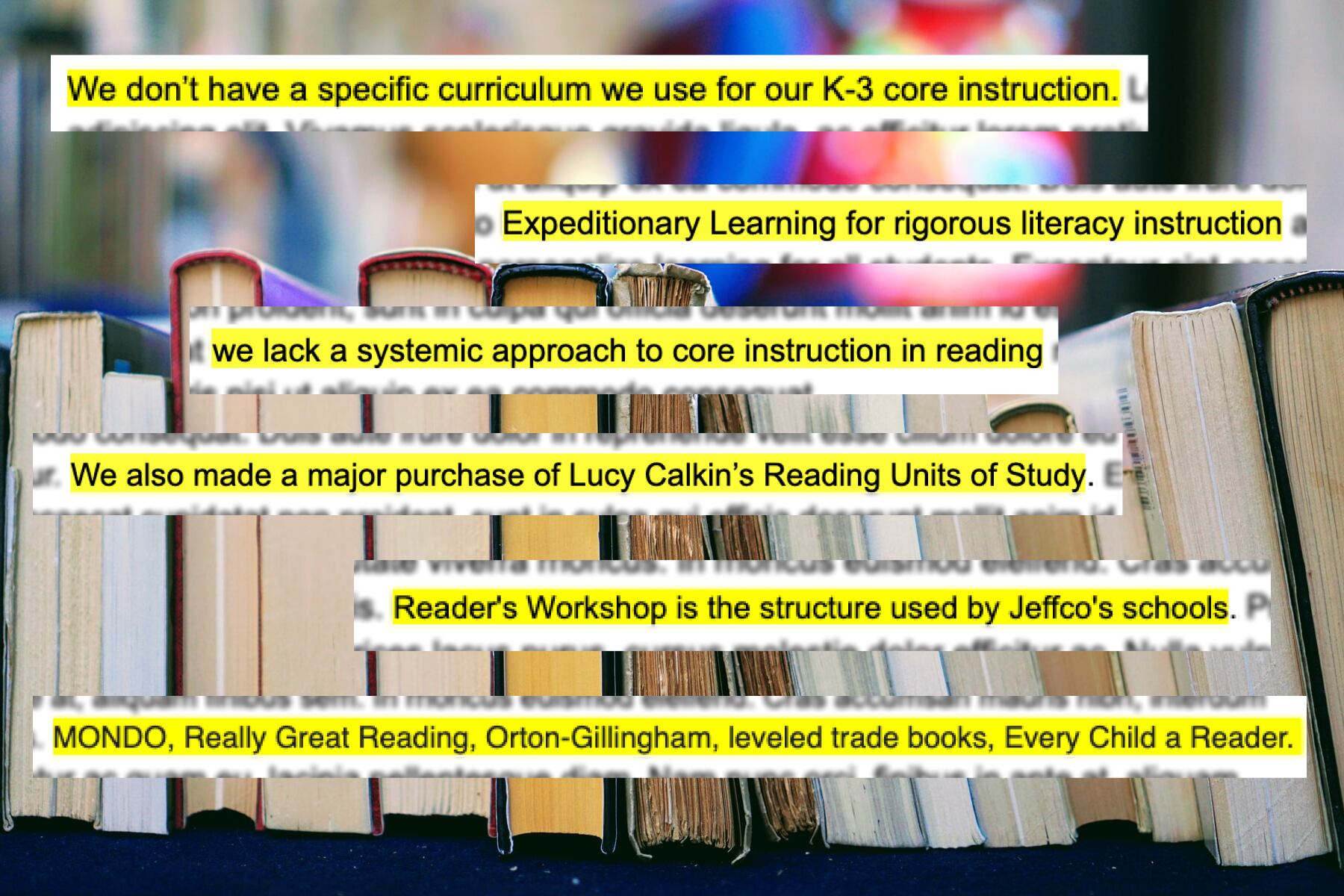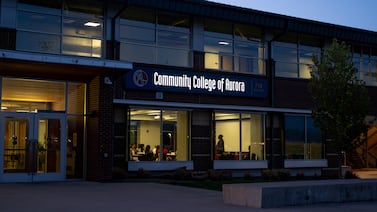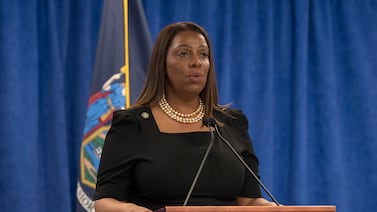Parents have asked. Community groups have asked. Media outlets have asked.
For two years, none have gotten a clear answer about the primary curriculums Jeffco’s 90 elementary and K-8 schools use to teach children how to read. District leaders told Chalkbeat that each school has the autonomy to select its own reading curriculum, but officials don’t track what schools have chosen.
A partial list compiled by Chalkbeat shows a patchwork quilt of reading curriculum in the 84,000-student district — with some schools using high-quality programs that have earned state approval and many others using programs the state has soundly rejected.
More than half of Colorado third-graders can’t read well, and the coronavirus pandemic will likely make matters worse. Experts say low-quality curriculum is part of the problem. But Colorado parents and the public often don’t know what their local schools use to teach reading.
Last winter, Chalkbeat filed public records requests to find out what K-3 reading curriculums Colorado’s 30 largest school districts use in their schools. Some districts initially said they’d charge for the information and others provided messy out-of-date lists.
Jeffco provided a simple answer — its own district-developed curriculum. Since then, Chalkbeat has learned that many schools in the district use reading programs officials never mentioned. It’s a black box that makes it hard for parents of struggling readers to figure out which schools can best help their children and obscures from public view the educational materials that schools spend millions of dollars on at taxpayer expense.
Amy Pitlik, government affairs director for the education advocacy group Stand For Children, said because Colorado is a local control state that can’t dictate what curriculum schools use, districts must be transparent so parents and the public can hold them accountable for their choices.
“We’ve failed to ask these questions for too long,” Pitlik said. “We’ve made it too easy for districts not to provide fundamental information about what students in kindergarten through third grade are getting in terms of core programming.”
That’s about to change — though not as much as some advocates had hoped.
A bill introduced last winter would have required schools to list their reading curriculum on their websites. Jeffco father Todd Porter, a pediatrician who has two children with dyslexia, told lawmakers at a hearing in March that curriculum transparency would be one step toward saving struggling readers.
“To me, it’s just hard to believe that you could have two schools down the street from each other that have completely different reading curriculums that could be based on nothing that has been ... validated,” he said this summer in an interview with Chalkbeat.
“The district doesn’t seem to have any oversight of what the individual school is doing,” he said of Jeffco.
Porter and his wife ultimately moved their children out of the district to a Littleton charter school.
Mediocre reading achievement
Asked how district officials ensure students are getting high-quality reading instruction without knowing which reading programs individual schools use, Matt Flores, the district’s chief academic officer, said in an email that educators in schools are responsible for that.
“Schools make intentional choices based on the needs of the students in their buildings,” Flores wrote.
Fewer than half of Jeffco’s third-graders read proficiently — 46% according to state test results from 2019, the most recent year available. While that’s a little higher than the statewide average of 41%, Jeffco rates lower than average on a second measure called a growth score.
The score is based on a 100-point scale and represents how much students with similar academic test histories improved from one year to the next. The statewide average is about 50. In 2019, Jeffco, the state’s second-largest district, earned a third-grade reading growth score of 47, the lowest among Colorado’s five largest districts.
The bill Porter supported never passed. But parents and members of the public — at least those with the time and ability to dig a little — will soon be able to find out which reading curriculums schools use, thanks to a 2019 state law.
A provision in that law, an update of the state’s 2012 READ Act, requires districts to report each school’s reading curriculum — and it must be evidence-based or scientifically based —to the state starting this school year. The information will be posted on the Colorado Department of Education website, inside the improvement plans school districts submit to the state.
A spokesman for the education department said the state will publicly post the plans, including the school-level reading curriculum information, a few weeks after they’re due. He said some districts, including Jeffco, have to submit the plans Oct. 15.
The state will post them online in early November. If districts request and receive extensions, they will be allowed to submit the reading curriculum information at a later date.
Waiting and wondering
In Jeffco, some parents have been trying to find out what’s used to teach reading at district schools for years.
JeffcoKID, a local advocacy group for dyslexic students, asked district officials for a list of reading curriculum by school two times in 2018. They never got a list.
“We never expected to not receive the information, so didn’t think to even put in a formal request through [the Colorado Open Records Act.] We just figured Jeffco was working on getting the list all this time,” Jen Halsall and Elisa Sodja, co-founders of JeffcoKID, said in an email.
The pair said JeffcoKID regularly gets requests from parents about which district schools use science-based structured literacy curriculums that will help their dyslexic children learn to read. Halsall and Sodja hoped to make a school-by-school curriculum list available on JeffcoKID’s Facebook pages so parents could find the best school match for their children.
Chalkbeat filed an open records request in January 2020 asking for the name of the district’s core literacy curriculum — the comprehensive program designed for all children in a classroom. District officials provided two answers: “Jeffco literacy curriculum” and “iCALI,” which stands for Interactive Comprehensive Approach to Literacy Instruction.
After follow-up questions from Chalkbeat, district officials provided further details about the two items. They described Jeffco’s literacy curriculum as “a unit-by-unit definition of what students must know, understand, and be able to do by the end of the unit of study and grade level.” They clarified that iCALI isn’t the district’s curriculum, but a collection of resources that “help teachers with the ‘how’ of teaching our curriculum.”
Last February, a member of the statewide dyslexia advocacy group, COKID, submitted an open records request asking for a school-by-school list of elementary reading curriculum. The district responded that iCALI was its core reading curriculum and provided no school-specific information.
What Jeffco didn’t mention to Chalkbeat or COKID was that many of its schools were actually using well-known — though not always well-respected — commercial reading curriculums. Flores, the chief academic officer, said by email that parents can always ask their child’s teacher or principal what reading program the school uses. But he didn’t offer an answer about how parents could learn that information for all district schools.
Piecing together the list
This summer, Chalkbeat attempted to compile a school-by-school list by reviewing every school’s website and state-mandated improvement plan, a document available online through the state. While more than two dozen Jeffco schools cited their reading programs in those places, many more did not.
In July, Chalkbeat asked to interview Jeffco’s lead literacy specialist to get more information about schools’ curriculum choices. District spokeswoman Cameron Bell provided some written answers, mentioning iCALI and linking to a spreadsheet that listed a host of allowable K-12 curriculums and textbooks. She also said no one was available for an interview and that school-specific curriculum information wouldn’t be collected till the fall.
Starting in August, Chalkbeat emailed nearly 80 Jeffco principals directly, including more than a dozen who head charter schools. Nearly 30 responded with answers about their curriculum, with several offering to provide additional details if needed. The rest either didn’t respond or referred Chalkbeat to the district’s communications office.
On Sept. 11, Bell said by email the district could provide a “comprehensive and validated” list of school-by-school reading curriculum to Chalkbeat on Oct. 9. Flores said this week by email that the list will be available to parents and community members, but didn’t say if it would be posted on the district’s or schools’ websites.
The partial list Chalkbeat compiled — covering about 60% of district-run and charter schools — shows wide variation in school curriculum choice, with at least nine commercial curriculums in play. Around 20 schools reported using programs that carry the state’s stamp of approval, such as Core Knowledge Language Arts, Wonders, Open Court, EL Education, and Into Reading.
At least two dozen other Jeffco schools use a curriculum the state has rejected and researchers have criticized for using methods that run counter to the science of reading. It’s called “Units of Study for Teaching Reading,” or more commonly Lucy Calkins.
State officials have said districts using curriculums that have failed their review process will have to make a good-faith effort to switch or will face consequences such as lowered accreditation ratings.
Several Jeffco schools reported using district-developed resources such as iCALI, or “Bridge to Curriculum,” the online location of the Jeffco literacy curriculum. Finally, a handful of schools reported that they don’t use any specific curriculum, use components from several programs, or are in the process of adopting new curriculum.
This story was produced with support from the Education Writers Association Reporting Fellowship program.






